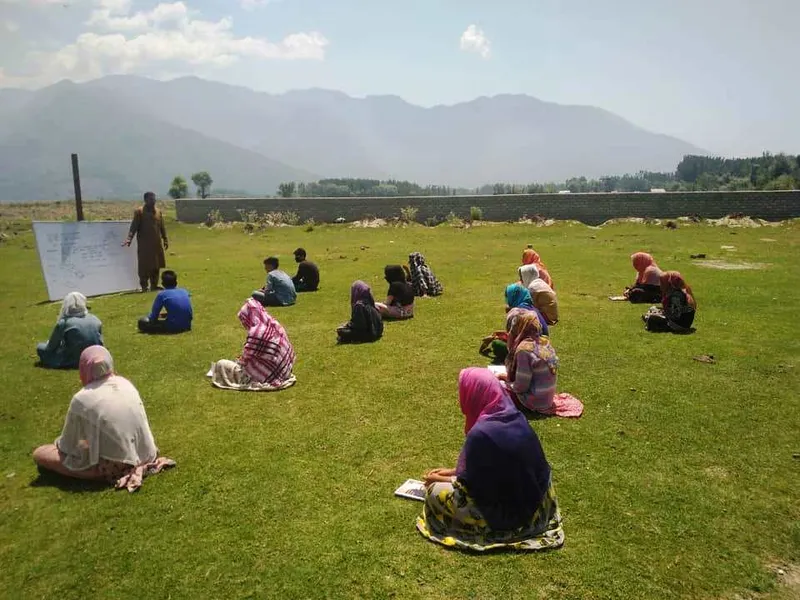Open-air classrooms under the shadows of COVID pandemic
Every cloud has a silver lining. And so it was for a group of children in rural Kashmir when some committed volunteer teachers brought, quite literally, the classroom to the village and spread learning and hope defying all odds.
While we mark this day to pay our respect to the teachers, the pandemic has shown how many of them have fought like the real front-line heroes in keeping children connected with education, no matter what it takes.
Just about a few days back, I came across a couple of heart-warming photographs that made my day. They were of some children, sitting in an open field (social distancing intact) and taking lessons from their teacher on a whiteboard erected on some easel, with big trees and distant mountain ranges silently overlooking.

These children were from a small village in Bandipora district, Kashmir, and the classes were being held by the volunteers from JKASW, a local NGO partner of CRY – Child Rights and You. While living with the COVID-19 pandemic for more than five months now, and having been exposed to many distressing news all around, these photographs did indeed bring in a welcome change.
Apart from instantly lifting my mood, the photographs initiated a trail of thoughts as well. Some quick questions and answers back and forth with our colleagues working on the ground and in charge of programmes in the State, I came to know that the closure of schools due to the outbreak of COVID-19 has had a grave impact on both school-going and out-of-school children.
It was worse for the children who had recently been rescued from child labour or already in vulnerable situation. This area is very prone to children getting employed because of the readily available opportunities – owing to the close proximity of the Wular Lake and the Jhelum River children get involved in fishing, sand dredging and water-nut collection.
In situations such as the outbreak of the pandemic or other emergencies, if children are engaged in education instead, chances of them getting employed reduce considerably. Not only are they engaged otherwise, they start dreaming of a better future and become more aware of the exploitative practises.
While the volunteers and our team in that area were already conducting classes over WhatsApp, our team felt it necessary for children to meet face-to-face to keep the interest alive. For children at risk, face-to-face interactions such as these were much more effective than virtual classes and helped keep them on track.

Also, there were a lot of children who couldn’t access internet at all. So, volunteers of our partner NGO wanted to ensure that there was no gap in education, and facilitated classes like these so that teachers could ensure maximum participation. These children used to live close by where the classes are held and needed no long distance travelling. Thus they brought the classes to the children, not just virtually, but actually!
From the very beginning of the nationwide lockdown announced to curb the spread of the coronavirus, we have been talking about the importance of figuring out alternative means in bringing the classroom to the children who are vulnerable to dropping out due to this sudden gap in schooling.
We have talked at length about why it is so important for education to continue, especially during adverse times. We were also thinking what could be the role of the teachers in these alternative methods of schooling, where they will have to look for logistics and be ready to walk extra miles to organise classes in the open air, when the whole world is lauding the ‘new normal’ of online education.
Further into the conversation, our NGO partner explained, “We wanted to enhance the indigenous capacity of the communities while increasing our outreach for education. Hence the project staff reached out to volunteers within the communities and motivated them to extend educational assistance to children.
Not only would it be easier for the volunteers to ensure that the children of their household and immediate neighbours get easier access to educational assistance, but also help to keep their engagement consistent and continuous.
The focus was also on maintaining safety protocols. In the end, we managed to reach out to 214 children in the age-group of 6-14 years and 66 children in the age group of 14-18 years through 55 such volunteers.”
Of course, these volunteer teachers have gone the extra mile to help the children around them. Especially now, during the pandemic, we have seen teachers go out of their way to help keep the continuum going for their students.
They have learnt new skills, adapted to the virtual teaching environment, adjusted their schedules, and become even more creative with their curriculum in order to keep students engaged.

We have always focused on the quality of teaching being crucial to determine whether students grow to their full potential, the dedication and sincerity of the teaching force towards the holistic growth of their students. What this pandemic has opened our eyes to, is that teachers are actually the pillars on which the education system stands – pillars that we don’t invest a lot in.
Not only do many of our schools don’t have enough teachers, the ones we have also need strong capacity building programs to enable them not just to tackle unprecedented situations like these, but also teach their students better.
A more focused investment into building the capacity of our teachers will definitely increase the quality of education delivered. It is also important to build an alternative human-force who can help deliver education to the children who do not have access to virtual mediums to continue their education.
Unless we figure out alternatives for them, the gap created in their education will become too wide to close. It is important to focus on teachers as teachers have definitely shown us over and over again that they are not a group that shy away from extra responsibility.
And while I say this, I suddenly realise which unspoken element in the photographs arrested me the most – apart from the students and the beautiful backdrops they were studying in, it was the teachers standing in front of the whiteboards, determined in salvaging the magic of physical connect – the warm and reassuring eye-contacts and smiles which were all lost in the lockdown.
This instantly reminds me of the iconic fantasy series written by JK Rowling, where Professor McGonagall once said with a surreptitious smile, “We teachers are rather good at magic, you know...”
(Disclaimer: The views and opinions expressed in this article are those of the author and do not necessarily reflect the views of YourStory.)








